Europe · Regions · Spain · Western Europe
A UNESCO tour of Andalusia’s three cultures
The rich history of Andalusia is in many respects the history of its three most influential cultures and their defining religions: Judaism, Islam and Christianity. Andalusia is a vast region of nearly 34 thousand square miles, with some cities established in excess of 3,000 years ago, some of the oldest in Europe. That’s a lot of history and a lot of geographical area to cover for the uninitiated; fortunately, Andalusia’s three cultures and many of the most important related UNESCO World Heritage sites can best be explored in and around just three of its capital cities: Granada, Cordoba and Seville.
 The Islamic Moors ruled the region of Al-Andaluz already from around the 8th century BC, when most of the European continent was languishing in the dark ages, and their rule lasted through the rest of the Medieval period. At this time the Moorish capitals in Cordoba and Granada were true centres of civilization and learning, while the three cultures lived in relative harmony. This harmony clearly and forever changed with the centuries long wars of the Christian Reconquest and subsequent Inquisition culminating in the 15th century. Though many cultural sites were lost during this time, the enduring legacies of all three cultures remain and can be explored with even a brief tour of Andalusia.
Granada
The Alhambra palace and Generalife Gardens in Granada are easily one of the most popular and well known UNESCO sites in Spain, indeed, one of the most visited tourist sites in the world. The fortress complex was the residence of the Moorish emirs after completion in the mid-thirteenth century and stands today as one of the best preserved examples of ancient Arabic architecture. The adjacent old Arabic neighbourhood known as the Albaycin still feels like a walk back in time with meandering, mazelike cobbled streets, tea houses and artisanal shops.
The Islamic Moors ruled the region of Al-Andaluz already from around the 8th century BC, when most of the European continent was languishing in the dark ages, and their rule lasted through the rest of the Medieval period. At this time the Moorish capitals in Cordoba and Granada were true centres of civilization and learning, while the three cultures lived in relative harmony. This harmony clearly and forever changed with the centuries long wars of the Christian Reconquest and subsequent Inquisition culminating in the 15th century. Though many cultural sites were lost during this time, the enduring legacies of all three cultures remain and can be explored with even a brief tour of Andalusia.
Granada
The Alhambra palace and Generalife Gardens in Granada are easily one of the most popular and well known UNESCO sites in Spain, indeed, one of the most visited tourist sites in the world. The fortress complex was the residence of the Moorish emirs after completion in the mid-thirteenth century and stands today as one of the best preserved examples of ancient Arabic architecture. The adjacent old Arabic neighbourhood known as the Albaycin still feels like a walk back in time with meandering, mazelike cobbled streets, tea houses and artisanal shops.
 In 1492, after the final victory of the Christian leaders over the Islamic Moors, the Alhambra became the royal court of Ferdinand and Isabella. They instituted some changes to the palaces in the Renaissance style, but the Alhambra remains undeniably Moorish overall to this day. It was here that Christopher Columbus received approval for his historic expedition.
In 1492, after the final victory of the Christian leaders over the Islamic Moors, the Alhambra became the royal court of Ferdinand and Isabella. They instituted some changes to the palaces in the Renaissance style, but the Alhambra remains undeniably Moorish overall to this day. It was here that Christopher Columbus received approval for his historic expedition.
 Granada also contains an important Sephardi museum focused on the history of the Sephardic Jews leading up to the time of the Inquisition. It is located in the city’s Jewish quarter, known as the Realejo, where further remnants of the Judaic influence on the city can be explored in more depth.
Cordoba
The most glorious period of Cordoban history began in the 8th century at the time of the original Moorish conquest and for the following two centuries Cordoba was the central urban and cultural focus of the western world. Some 300 mosques, countless palaces and civic structures were built to establish Cordoba as a centre of civilization to rival Constantinople, Baghdad and Damascus. Hundreds of these ancient buildings still stand as testament to the legacy of the cultures that produced them and can still be explored. Such is the historical import of the centre of Cordoba that the entire urban centre was awarded a UNESCO World Heritage designation and any observant stroll through the area unveils a wealth of culture and history.
The most famous site in Cordoba is the Mezquita, itself a UNESCO site, oft referred to as the Mosque-Cathedral for obvious reasons once you’ve seen it. The sheer size of the original mosque made a bold statement, as did the building techniques that influenced subsequent Arabic and Christian designs thereafter. But the most unique and incongruent feature of the modern structure arises from the changes made by the Christian rulers after the Moors were expelled. Essentially, the mosque was preserved with its forest of columns and Arabic arches supporting a roof at unheard of heights for the time, yet smack in the middle of the mosque a Christian cathedral was constructed.
Granada also contains an important Sephardi museum focused on the history of the Sephardic Jews leading up to the time of the Inquisition. It is located in the city’s Jewish quarter, known as the Realejo, where further remnants of the Judaic influence on the city can be explored in more depth.
Cordoba
The most glorious period of Cordoban history began in the 8th century at the time of the original Moorish conquest and for the following two centuries Cordoba was the central urban and cultural focus of the western world. Some 300 mosques, countless palaces and civic structures were built to establish Cordoba as a centre of civilization to rival Constantinople, Baghdad and Damascus. Hundreds of these ancient buildings still stand as testament to the legacy of the cultures that produced them and can still be explored. Such is the historical import of the centre of Cordoba that the entire urban centre was awarded a UNESCO World Heritage designation and any observant stroll through the area unveils a wealth of culture and history.
The most famous site in Cordoba is the Mezquita, itself a UNESCO site, oft referred to as the Mosque-Cathedral for obvious reasons once you’ve seen it. The sheer size of the original mosque made a bold statement, as did the building techniques that influenced subsequent Arabic and Christian designs thereafter. But the most unique and incongruent feature of the modern structure arises from the changes made by the Christian rulers after the Moors were expelled. Essentially, the mosque was preserved with its forest of columns and Arabic arches supporting a roof at unheard of heights for the time, yet smack in the middle of the mosque a Christian cathedral was constructed.
 The old centre of Cordoba also includes the Jewish Quarter, with numerous historic synagogues, including a very notable one from 1315 combining Christian and Islamic architectural design. Nearby Lucena was founded as an entirely Jewish city during the Muslim rule of Spain in the 11th century. There lies the largest Sephardi necropolis in Spain with more than 370 tombs.
The old centre of Cordoba also includes the Jewish Quarter, with numerous historic synagogues, including a very notable one from 1315 combining Christian and Islamic architectural design. Nearby Lucena was founded as an entirely Jewish city during the Muslim rule of Spain in the 11th century. There lies the largest Sephardi necropolis in Spain with more than 370 tombs.
 Spain’s newest UNESCO World Heritage designation was awarded in July, 2018 to the Medina Azahara, a settlement designed as the residence of the first Caliph from Cordoba, on the city’s outskirts, and built between the years 936-976. Not just a palace, but a city complex housing the civil and military administration of the state, the Medina Azahara was intended to signify the greatness and dignity of Abd al-Rahman III, who had declared himself the highest leader of all Islam, and Mohammed’s successor. What makes the site most impressive and important today is that, unlike other monuments from the Hispanomuslim era, neither its structure nor decoration have been altered with later modifications. It stands as a pure archeological site and allows close and accurate inspection of the past.
Spain’s newest UNESCO World Heritage designation was awarded in July, 2018 to the Medina Azahara, a settlement designed as the residence of the first Caliph from Cordoba, on the city’s outskirts, and built between the years 936-976. Not just a palace, but a city complex housing the civil and military administration of the state, the Medina Azahara was intended to signify the greatness and dignity of Abd al-Rahman III, who had declared himself the highest leader of all Islam, and Mohammed’s successor. What makes the site most impressive and important today is that, unlike other monuments from the Hispanomuslim era, neither its structure nor decoration have been altered with later modifications. It stands as a pure archeological site and allows close and accurate inspection of the past.
 Seville
Our initial tour of the most important UNESCO sites highlighting Andalusia’s Three Cultures leads us to a very centralised area of Seville, with the Cathedral, Alcazar and Archivo de Indias. This monumental complex in the heart of the city pays homage to the “Golden Age” of Spain, as the nation consolidated its royal sovereignty and immense trading power acquired through its New World colonies.
The city immediately exhibits a more modern wealth than its counterparts in Granada and Cordoba, though the original Alcazar (fortified palace) was constructed in the 10th century, around the same time as those others under the Moors, as a palace for the Muslim governor of the region. It has been built and rebuilt, reformed and altered throughout the ages, from Medieval to modern times. As such it is a study in architecture across the eras, both within the walls and in the extensive gardens attached, from the original Moorish Almohad style to Renaissance and through Neoclassical. It is used today as the royal residence in Seville, in keeping with its original purpose.
Founded in 1403, the Cathedral was built on the site of a centuries old mosque. Unlike the one in Cordoba, the Christian rulers razed most of the old structure and built a true Gothic/Renaissance Cathedral, still today the largest Gothic structure in Europe and the third largest Cathedral in the world. Its Moorish, Islamic roots are still visible today, however, most notably in the Giralda tower (the former minaret of the mosque) and the orange tree-lined courtyard fragrant with orange blossom. A sarcophagus within is said to contain the remains of Christopher Columbus.
Seville
Our initial tour of the most important UNESCO sites highlighting Andalusia’s Three Cultures leads us to a very centralised area of Seville, with the Cathedral, Alcazar and Archivo de Indias. This monumental complex in the heart of the city pays homage to the “Golden Age” of Spain, as the nation consolidated its royal sovereignty and immense trading power acquired through its New World colonies.
The city immediately exhibits a more modern wealth than its counterparts in Granada and Cordoba, though the original Alcazar (fortified palace) was constructed in the 10th century, around the same time as those others under the Moors, as a palace for the Muslim governor of the region. It has been built and rebuilt, reformed and altered throughout the ages, from Medieval to modern times. As such it is a study in architecture across the eras, both within the walls and in the extensive gardens attached, from the original Moorish Almohad style to Renaissance and through Neoclassical. It is used today as the royal residence in Seville, in keeping with its original purpose.
Founded in 1403, the Cathedral was built on the site of a centuries old mosque. Unlike the one in Cordoba, the Christian rulers razed most of the old structure and built a true Gothic/Renaissance Cathedral, still today the largest Gothic structure in Europe and the third largest Cathedral in the world. Its Moorish, Islamic roots are still visible today, however, most notably in the Giralda tower (the former minaret of the mosque) and the orange tree-lined courtyard fragrant with orange blossom. A sarcophagus within is said to contain the remains of Christopher Columbus.
 The third UNESCO listed site comprising the central complex is a relatively later construct. Built in 1585 to house a merchants consulate, the Archivo de Indias was converted in 1785 to house the greatest collection of documents relating to the discovery of the New World and subsequent relations; modern testament to the fact that Seville held a virtual monopoly on trade to the New World and “the Indies” for some 200 years.
With this somewhat superficial glimpse into the enormously deep and complex history of Andalusia’s Three Cultures, with reference to the many well deserved UNESCO sites, it should be possible for the resourceful traveller to plan and experience a highly illuminating tour. However, for a professional and expertly guided exploration, a bespoke travel planner such as Toma & Coe can unearth and explain sights, sites and history that would otherwise be nearly impossible. Meanwhile, a specialist culinary tour operator such as Paladar y Tomar can guide you through a delectable exploration of Andalusia’s Three Cultures with a tailor made gastronomic tour of the culinary legacies of the Jews, Muslims and Christians in the region.
Alan Hazel is Owner and Director of Cortijo El Carligto. Cortijo el Carligto is a private Andalucían hideaway and luxury rental estate in the hills of Malaga, Spain, overlooking the Mediterranean.
If you would like to be a guest blogger on A Luxury Travel Blog in order to raise your profile, please contact us.
The third UNESCO listed site comprising the central complex is a relatively later construct. Built in 1585 to house a merchants consulate, the Archivo de Indias was converted in 1785 to house the greatest collection of documents relating to the discovery of the New World and subsequent relations; modern testament to the fact that Seville held a virtual monopoly on trade to the New World and “the Indies” for some 200 years.
With this somewhat superficial glimpse into the enormously deep and complex history of Andalusia’s Three Cultures, with reference to the many well deserved UNESCO sites, it should be possible for the resourceful traveller to plan and experience a highly illuminating tour. However, for a professional and expertly guided exploration, a bespoke travel planner such as Toma & Coe can unearth and explain sights, sites and history that would otherwise be nearly impossible. Meanwhile, a specialist culinary tour operator such as Paladar y Tomar can guide you through a delectable exploration of Andalusia’s Three Cultures with a tailor made gastronomic tour of the culinary legacies of the Jews, Muslims and Christians in the region.
Alan Hazel is Owner and Director of Cortijo El Carligto. Cortijo el Carligto is a private Andalucían hideaway and luxury rental estate in the hills of Malaga, Spain, overlooking the Mediterranean.
If you would like to be a guest blogger on A Luxury Travel Blog in order to raise your profile, please contact us.
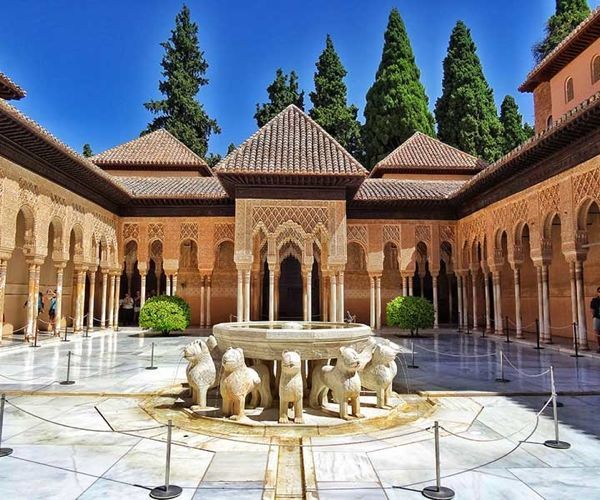 The Islamic Moors ruled the region of Al-Andaluz already from around the 8th century BC, when most of the European continent was languishing in the dark ages, and their rule lasted through the rest of the Medieval period. At this time the Moorish capitals in Cordoba and Granada were true centres of civilization and learning, while the three cultures lived in relative harmony. This harmony clearly and forever changed with the centuries long wars of the Christian Reconquest and subsequent Inquisition culminating in the 15th century. Though many cultural sites were lost during this time, the enduring legacies of all three cultures remain and can be explored with even a brief tour of Andalusia.
Granada
The Alhambra palace and Generalife Gardens in Granada are easily one of the most popular and well known UNESCO sites in Spain, indeed, one of the most visited tourist sites in the world. The fortress complex was the residence of the Moorish emirs after completion in the mid-thirteenth century and stands today as one of the best preserved examples of ancient Arabic architecture. The adjacent old Arabic neighbourhood known as the Albaycin still feels like a walk back in time with meandering, mazelike cobbled streets, tea houses and artisanal shops.
The Islamic Moors ruled the region of Al-Andaluz already from around the 8th century BC, when most of the European continent was languishing in the dark ages, and their rule lasted through the rest of the Medieval period. At this time the Moorish capitals in Cordoba and Granada were true centres of civilization and learning, while the three cultures lived in relative harmony. This harmony clearly and forever changed with the centuries long wars of the Christian Reconquest and subsequent Inquisition culminating in the 15th century. Though many cultural sites were lost during this time, the enduring legacies of all three cultures remain and can be explored with even a brief tour of Andalusia.
Granada
The Alhambra palace and Generalife Gardens in Granada are easily one of the most popular and well known UNESCO sites in Spain, indeed, one of the most visited tourist sites in the world. The fortress complex was the residence of the Moorish emirs after completion in the mid-thirteenth century and stands today as one of the best preserved examples of ancient Arabic architecture. The adjacent old Arabic neighbourhood known as the Albaycin still feels like a walk back in time with meandering, mazelike cobbled streets, tea houses and artisanal shops.
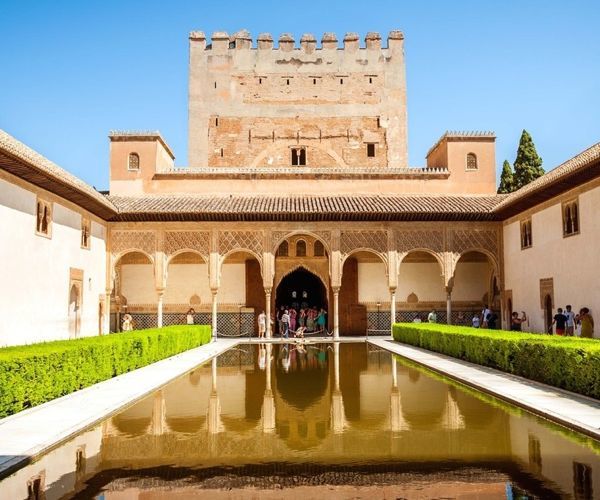 In 1492, after the final victory of the Christian leaders over the Islamic Moors, the Alhambra became the royal court of Ferdinand and Isabella. They instituted some changes to the palaces in the Renaissance style, but the Alhambra remains undeniably Moorish overall to this day. It was here that Christopher Columbus received approval for his historic expedition.
In 1492, after the final victory of the Christian leaders over the Islamic Moors, the Alhambra became the royal court of Ferdinand and Isabella. They instituted some changes to the palaces in the Renaissance style, but the Alhambra remains undeniably Moorish overall to this day. It was here that Christopher Columbus received approval for his historic expedition.
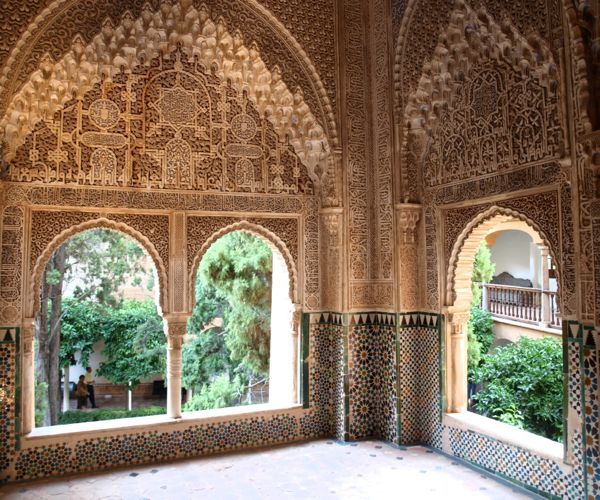 Granada also contains an important Sephardi museum focused on the history of the Sephardic Jews leading up to the time of the Inquisition. It is located in the city’s Jewish quarter, known as the Realejo, where further remnants of the Judaic influence on the city can be explored in more depth.
Cordoba
The most glorious period of Cordoban history began in the 8th century at the time of the original Moorish conquest and for the following two centuries Cordoba was the central urban and cultural focus of the western world. Some 300 mosques, countless palaces and civic structures were built to establish Cordoba as a centre of civilization to rival Constantinople, Baghdad and Damascus. Hundreds of these ancient buildings still stand as testament to the legacy of the cultures that produced them and can still be explored. Such is the historical import of the centre of Cordoba that the entire urban centre was awarded a UNESCO World Heritage designation and any observant stroll through the area unveils a wealth of culture and history.
The most famous site in Cordoba is the Mezquita, itself a UNESCO site, oft referred to as the Mosque-Cathedral for obvious reasons once you’ve seen it. The sheer size of the original mosque made a bold statement, as did the building techniques that influenced subsequent Arabic and Christian designs thereafter. But the most unique and incongruent feature of the modern structure arises from the changes made by the Christian rulers after the Moors were expelled. Essentially, the mosque was preserved with its forest of columns and Arabic arches supporting a roof at unheard of heights for the time, yet smack in the middle of the mosque a Christian cathedral was constructed.
Granada also contains an important Sephardi museum focused on the history of the Sephardic Jews leading up to the time of the Inquisition. It is located in the city’s Jewish quarter, known as the Realejo, where further remnants of the Judaic influence on the city can be explored in more depth.
Cordoba
The most glorious period of Cordoban history began in the 8th century at the time of the original Moorish conquest and for the following two centuries Cordoba was the central urban and cultural focus of the western world. Some 300 mosques, countless palaces and civic structures were built to establish Cordoba as a centre of civilization to rival Constantinople, Baghdad and Damascus. Hundreds of these ancient buildings still stand as testament to the legacy of the cultures that produced them and can still be explored. Such is the historical import of the centre of Cordoba that the entire urban centre was awarded a UNESCO World Heritage designation and any observant stroll through the area unveils a wealth of culture and history.
The most famous site in Cordoba is the Mezquita, itself a UNESCO site, oft referred to as the Mosque-Cathedral for obvious reasons once you’ve seen it. The sheer size of the original mosque made a bold statement, as did the building techniques that influenced subsequent Arabic and Christian designs thereafter. But the most unique and incongruent feature of the modern structure arises from the changes made by the Christian rulers after the Moors were expelled. Essentially, the mosque was preserved with its forest of columns and Arabic arches supporting a roof at unheard of heights for the time, yet smack in the middle of the mosque a Christian cathedral was constructed.
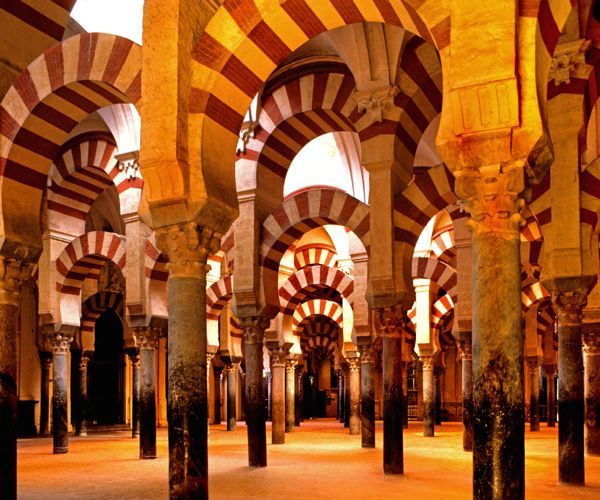 The old centre of Cordoba also includes the Jewish Quarter, with numerous historic synagogues, including a very notable one from 1315 combining Christian and Islamic architectural design. Nearby Lucena was founded as an entirely Jewish city during the Muslim rule of Spain in the 11th century. There lies the largest Sephardi necropolis in Spain with more than 370 tombs.
The old centre of Cordoba also includes the Jewish Quarter, with numerous historic synagogues, including a very notable one from 1315 combining Christian and Islamic architectural design. Nearby Lucena was founded as an entirely Jewish city during the Muslim rule of Spain in the 11th century. There lies the largest Sephardi necropolis in Spain with more than 370 tombs.
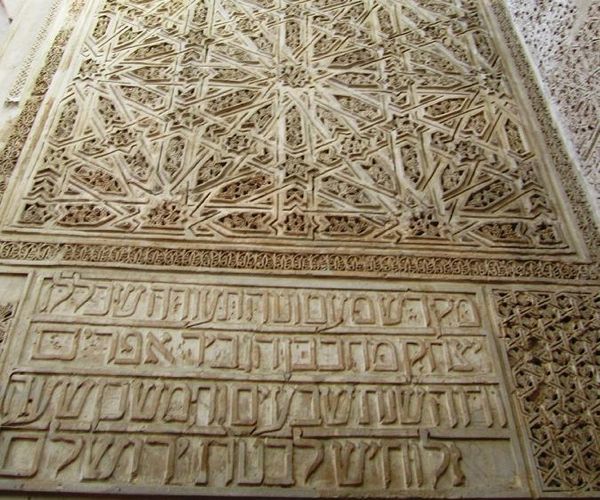 Spain’s newest UNESCO World Heritage designation was awarded in July, 2018 to the Medina Azahara, a settlement designed as the residence of the first Caliph from Cordoba, on the city’s outskirts, and built between the years 936-976. Not just a palace, but a city complex housing the civil and military administration of the state, the Medina Azahara was intended to signify the greatness and dignity of Abd al-Rahman III, who had declared himself the highest leader of all Islam, and Mohammed’s successor. What makes the site most impressive and important today is that, unlike other monuments from the Hispanomuslim era, neither its structure nor decoration have been altered with later modifications. It stands as a pure archeological site and allows close and accurate inspection of the past.
Spain’s newest UNESCO World Heritage designation was awarded in July, 2018 to the Medina Azahara, a settlement designed as the residence of the first Caliph from Cordoba, on the city’s outskirts, and built between the years 936-976. Not just a palace, but a city complex housing the civil and military administration of the state, the Medina Azahara was intended to signify the greatness and dignity of Abd al-Rahman III, who had declared himself the highest leader of all Islam, and Mohammed’s successor. What makes the site most impressive and important today is that, unlike other monuments from the Hispanomuslim era, neither its structure nor decoration have been altered with later modifications. It stands as a pure archeological site and allows close and accurate inspection of the past.
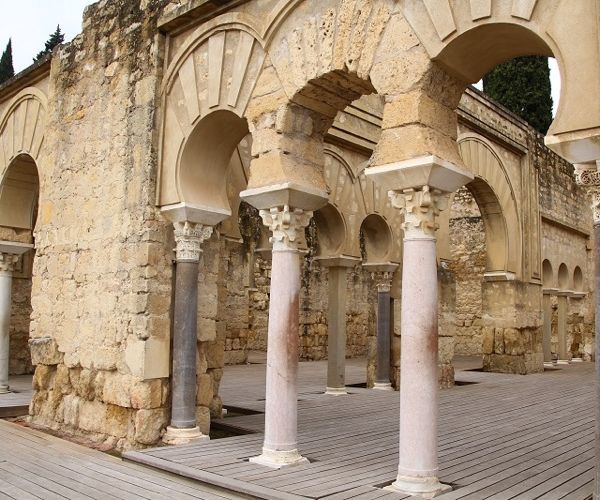 Seville
Our initial tour of the most important UNESCO sites highlighting Andalusia’s Three Cultures leads us to a very centralised area of Seville, with the Cathedral, Alcazar and Archivo de Indias. This monumental complex in the heart of the city pays homage to the “Golden Age” of Spain, as the nation consolidated its royal sovereignty and immense trading power acquired through its New World colonies.
The city immediately exhibits a more modern wealth than its counterparts in Granada and Cordoba, though the original Alcazar (fortified palace) was constructed in the 10th century, around the same time as those others under the Moors, as a palace for the Muslim governor of the region. It has been built and rebuilt, reformed and altered throughout the ages, from Medieval to modern times. As such it is a study in architecture across the eras, both within the walls and in the extensive gardens attached, from the original Moorish Almohad style to Renaissance and through Neoclassical. It is used today as the royal residence in Seville, in keeping with its original purpose.
Founded in 1403, the Cathedral was built on the site of a centuries old mosque. Unlike the one in Cordoba, the Christian rulers razed most of the old structure and built a true Gothic/Renaissance Cathedral, still today the largest Gothic structure in Europe and the third largest Cathedral in the world. Its Moorish, Islamic roots are still visible today, however, most notably in the Giralda tower (the former minaret of the mosque) and the orange tree-lined courtyard fragrant with orange blossom. A sarcophagus within is said to contain the remains of Christopher Columbus.
Seville
Our initial tour of the most important UNESCO sites highlighting Andalusia’s Three Cultures leads us to a very centralised area of Seville, with the Cathedral, Alcazar and Archivo de Indias. This monumental complex in the heart of the city pays homage to the “Golden Age” of Spain, as the nation consolidated its royal sovereignty and immense trading power acquired through its New World colonies.
The city immediately exhibits a more modern wealth than its counterparts in Granada and Cordoba, though the original Alcazar (fortified palace) was constructed in the 10th century, around the same time as those others under the Moors, as a palace for the Muslim governor of the region. It has been built and rebuilt, reformed and altered throughout the ages, from Medieval to modern times. As such it is a study in architecture across the eras, both within the walls and in the extensive gardens attached, from the original Moorish Almohad style to Renaissance and through Neoclassical. It is used today as the royal residence in Seville, in keeping with its original purpose.
Founded in 1403, the Cathedral was built on the site of a centuries old mosque. Unlike the one in Cordoba, the Christian rulers razed most of the old structure and built a true Gothic/Renaissance Cathedral, still today the largest Gothic structure in Europe and the third largest Cathedral in the world. Its Moorish, Islamic roots are still visible today, however, most notably in the Giralda tower (the former minaret of the mosque) and the orange tree-lined courtyard fragrant with orange blossom. A sarcophagus within is said to contain the remains of Christopher Columbus.
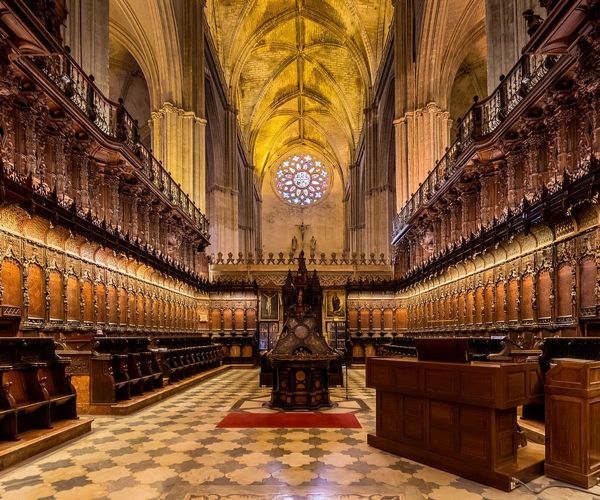 The third UNESCO listed site comprising the central complex is a relatively later construct. Built in 1585 to house a merchants consulate, the Archivo de Indias was converted in 1785 to house the greatest collection of documents relating to the discovery of the New World and subsequent relations; modern testament to the fact that Seville held a virtual monopoly on trade to the New World and “the Indies” for some 200 years.
With this somewhat superficial glimpse into the enormously deep and complex history of Andalusia’s Three Cultures, with reference to the many well deserved UNESCO sites, it should be possible for the resourceful traveller to plan and experience a highly illuminating tour. However, for a professional and expertly guided exploration, a bespoke travel planner such as Toma & Coe can unearth and explain sights, sites and history that would otherwise be nearly impossible. Meanwhile, a specialist culinary tour operator such as Paladar y Tomar can guide you through a delectable exploration of Andalusia’s Three Cultures with a tailor made gastronomic tour of the culinary legacies of the Jews, Muslims and Christians in the region.
Alan Hazel is Owner and Director of Cortijo El Carligto. Cortijo el Carligto is a private Andalucían hideaway and luxury rental estate in the hills of Malaga, Spain, overlooking the Mediterranean.
If you would like to be a guest blogger on A Luxury Travel Blog in order to raise your profile, please contact us.
The third UNESCO listed site comprising the central complex is a relatively later construct. Built in 1585 to house a merchants consulate, the Archivo de Indias was converted in 1785 to house the greatest collection of documents relating to the discovery of the New World and subsequent relations; modern testament to the fact that Seville held a virtual monopoly on trade to the New World and “the Indies” for some 200 years.
With this somewhat superficial glimpse into the enormously deep and complex history of Andalusia’s Three Cultures, with reference to the many well deserved UNESCO sites, it should be possible for the resourceful traveller to plan and experience a highly illuminating tour. However, for a professional and expertly guided exploration, a bespoke travel planner such as Toma & Coe can unearth and explain sights, sites and history that would otherwise be nearly impossible. Meanwhile, a specialist culinary tour operator such as Paladar y Tomar can guide you through a delectable exploration of Andalusia’s Three Cultures with a tailor made gastronomic tour of the culinary legacies of the Jews, Muslims and Christians in the region.
Alan Hazel is Owner and Director of Cortijo El Carligto. Cortijo el Carligto is a private Andalucían hideaway and luxury rental estate in the hills of Malaga, Spain, overlooking the Mediterranean.
If you would like to be a guest blogger on A Luxury Travel Blog in order to raise your profile, please contact us.Did you enjoy this article?
Receive similar content direct to your inbox.


These places all sound phenomenal! For me as an adventurous traveller I love visiting places rich in history like this. I enjoy learning about the religious undertones of history too and how it reflects into the architecture. I have been to Seville and it is just stunning and there is so much to see and take in there. I am a sucker for visiting places with gothic cathedrals.
In someways it is such a pity that these three cities are often grouped together and trip off the tongue to be covered in one whistle-stop tour of Southern Spain.
I’ve visited them individually over a decade. On each visit to Spain I spent at least four days in each destination, most recently I had learnt my lesson and I devoted a week to Corfoba.
They all have so much to offer. It pays to take your time. Slow down and savour the small courtyards, the crnturies Old architects’s craftsmanship.
I’m just back from a wonderful trip driving around the beautiful region that is Andalusia. I think you’ve got it right when you talk about the three cultures contributing to the area’s architecture and history. Incredibly there were even periods when Christians, Jews and Moslems lived happily alongside each other. On a serious note that has helped the artefacts of each culture to survive reasonably intact. A lesson for us all today.